Quick Answer: TV shows and movies can both educate and stigmatize when it comes to STDs. Storylines that repeat accurate messaging, like safe sex, testing, and living with HIV, can boost awareness and reduce shame, especially when tied to realistic characters. But sensational or one-off portrayals often lean into fear, misinformation, or shame. Context, frequency, and framing matter.
When Soaps Save Lives: HIV Storylines That Got Real
Some of the earliest public-facing STD narratives appeared in long‑running soap operas. EastEnders introduced Mark Fowler’s HIV diagnosis in 1991, reaching millions weekly and becoming a major source of awareness for teens, surpassing nonfiction health campaigns in perceived influence by the late 1990s. That storyline helped shift public perception of HIV and taught viewers about transmission and testing in a compelling character arc.
Similarly, the British soap Hollyoaks launched a breakthrough storyline in 2015 when Ste Hay tested HIV‑positive. Partnering with Terrence Higgins Trust, the show portrayed real-time testing and emotional fallout, encouraging viewers to test and talk about risk in a way that felt both raw and hopeful.

People are also reading: Ozempic, HIV, and Hepatitis: What the Research Really Shows
Repeat Exposure Boosts Awareness, Not Just Shock
Studies show that repeated exposure to health-related storylines, across multiple episodes or characters, builds real awareness and shifts norms more than isolated episodes. For instance, meta-analysis evidence shows that mass media interventions can modestly reduce HIV-related stigma over time, but only if exposure is consistent and contextually relevant.
That’s why shows like Sex Education, which revisit STI themes, testing, consent, risk, across seasons, get credit for normalizing conversations and reducing fear. One qualitative study highlights how it frames sexual health as ongoing learning rather than moral failing.
Films Tend to Be Accurate, But Often With One Fatal Twist
A scoping review of 77 films found that 87% portrayed STI symptoms, transmission, diagnosis, and treatment accurately, but many still leaned into death-related or moralizing story arcs. HIV, in particular, often ends in tragedy on screen even when real-world management is possible, sometimes reinforcing outdated fears despite clinical accuracy.
This mismatch matters: accurate STD detail matters, but if most narrative arcs end in fear or punishment, viewers can still walk away feeling ashamed, not informed.
When the Message Misses: STD Storylines That Backfired
Even well-meaning shows can miss the mark when they prioritize drama over accuracy. A prime example? “Glee.” In season 5, when a character discloses they have HPV, the plot goes nowhere. No talk of partner notification, no medical information, just a vague moral cloud. Or take “Grey’s Anatomy,” where an HSV diagnosis once caused a near-breakup but was never revisited again, undermining the message that herpes is manageable, common, and not a relationship death sentence.
These missed moments don’t just leave gaps, they reinforce stigma. When a character is shown panicking, crying, or recoiling in horror without any counter-messaging, the viewer absorbs that response too. Even if the facts are correct, the tone often isn’t. Tone is everything. Especially for teens and queer audiences, who are more likely to encounter misinformation and fear-based messaging elsewhere.
Check Your STD Status in Minutes
Test at Home with Remedium3-in-1 STD Test Kit

 For Men & Women
For Men & Women Results in Minutes
Results in Minutes No Lab Needed
No Lab Needed Private & Discreet
Private & DiscreetOrder Now $69.00 $147.00
For all 3 tests
Double Standards: Who Gets to Have an STD On Screen?
Another problem? Representation. When straight white characters test positive or talk about STDs, they often get redemption arcs or education-focused scenes. But when Black, queer, or trans characters are involved, the tone shifts, often into tropes of irresponsibility, danger, or "cautionary tale" territory.
This creates a toxic hierarchy of sexual health where marginalized identities are seen as vectors, not victims. A Black woman with chlamydia might be written as reckless. A white male character with the same diagnosis gets a growth moment and a second chance. It’s subtle but pervasive, and viewers internalize it.
We need narratives that show everyone can have an STI and still be safe, desirable, and worthy of love. Normalizing risk across identity lines is how we start dismantling the shame web, not reinforcing it with bias in storytelling.
Sex, Jokes, and Testing: When Humor Gets It Right
Believe it or not, some of the best STD awareness in media comes from comedies. Why? Because humor can disarm stigma. Shows like “Broad City” and “Big Mouth” introduce STI testing as casual, even funny, experiences, no dramatics, no humiliation, just normal human moments that say, “This is part of sex.”
In “Broad City,” when Ilana’s partner mentions he has HPV, her response is nonchalant: “Who doesn’t?” That moment alone has been cited in multiple public health forums as a low-key destigmatizing masterstroke. No shame. No panic. Just... facts. Delivered with humor and love.
These kinds of scenes change everything. They model emotionally safe ways to talk about sexual health, and they don’t make it weird. For many viewers, laughter becomes the gateway to knowledge. And that’s a good thing.
Trauma-Informed Writing vs. Trauma-Exploiting Drama
Too many STD portrayals fall into a familiar trap: they sensationalize. A character tests positive, spirals, gets dumped, or worse. Then the issue vanishes from the plot, leaving a toxic trail of emotional fallout. This is especially harmful when the storyline uses trauma as a plot twist rather than a journey.
Trauma-informed storytelling takes time to show the whole arc: the confusion, the medical facts, the support, the healing. It shows you can get an STD and still thrive. It lets characters feel fear without reinforcing shame. Think “Pose,” where HIV isn’t just a threat, it’s a thread woven through community, survival, and radical love.
When writers take shortcuts for ratings, they leave real people holding that shame. But when they take the time to tell full, messy, resilient stories? That’s when media becomes medicine.

People are also reading: Herpes, HPV, Hep B: What You Need to Know About STD Vaccines
How Media Storylines Influence Real Testing Behavior
We’re not just guessing when we say TV and film shape behavior, research backs it up. Studies show that well-written STD storylines can directly influence viewers to seek testing, ask questions, and change attitudes about sexual risk. One UCLA study found that teens who watched shows like “ER” or “Grey’s Anatomy” featuring medical discussions about HIV were more likely to recall facts correctly and express intent to get tested within six months.
Another report published in AIDS and Behavior tracked a 30% increase in Google searches related to HIV testing in the week after major HIV-themed TV episodes aired. And when Planned Parenthood partnered with writers from shows like “The Fosters,” call volumes to their teen health hotline spiked by 25% the following week.
That’s the power of screen time: when characters get tested, viewers follow. When they avoid it or spiral in shame, viewers absorb that too. What we see shapes what we think is normal, and what we think is possible.
What Viewers Want: Real Talk, Not Fear Porn
Surveys show audiences don’t want melodrama, they want honesty. A 2022 survey by the Guttmacher Institute found that viewers responded more positively to STD storylines that were medically accurate, emotionally nuanced, and followed up with clear next steps like treatment or disclosure tips.
In contrast, episodes that used STDs for shock value (like surprise reveals or as punishments for infidelity) triggered more fear and confusion. Viewers reported feeling “ashamed,” “grossed out,” or “hopeless” after watching, even if the story technically ended in a happy resolution. That’s the problem with using health as horror: it may grab attention, but it doesn’t build understanding.
We need fewer “gotcha” moments and more grounded, ongoing conversations. Especially when characters reflect real-world audiences, Black, queer, disabled, or living with chronic conditions, the bar has to be higher. Entertainment should uplift, not retraumatize.
How One Line Can Change a Life
Sometimes, all it takes is one line. One character saying, “I get tested regularly, it’s just part of how I care for myself.” Or, “Yeah, I had herpes. It’s not a big deal, I manage it like anything else.” That kind of casual, stigma-free representation is radical. Because it tells viewers: you’re not alone. You’re not disgusting. You’re just human.
Representation works best when it’s baked into the fabric of a story, not tacked on like a PSA. Viewers can tell when a scene is checking a box. But when it feels real, lived in, like a normal part of a character’s world, it sinks in. That’s the moment when a teenager realizes testing isn’t scary. Or when someone newly diagnosed sees themselves not as a cautionary tale, but as a person worth loving.
Those little lines? They’re lifelines. Writers, take note.
Check Your STD Status in Minutes
Test at Home with RemediumChlamydia & Gonorrhea Test

 For Men & Women
For Men & Women Results in Minutes
Results in Minutes No Lab Needed
No Lab Needed Private & Discreet
Private & DiscreetOrder Now $49.00 $98.00
For all 2 tests
Beyond Hollywood: How Global TV Talks About STDs
While American media dominates much of the global entertainment landscape, some of the most progressive and realistic STD education through TV and film comes from outside the U.S. In South Africa, the soap opera Intersexions aired with support from the country’s health department and explicitly focused on HIV transmission, relationship dynamics, and testing. It didn't just inform viewers, it changed behavior. A study found viewers were significantly more likely to use condoms and discuss HIV status with partners after watching the show.
In Brazil, telenovelas have long tackled issues like HIV, reproductive rights, and sexual violence in emotionally rich narratives that don’t shy away from complexity. Shows like Malhação and Amor à Vida featured HIV-positive characters living normal, loving lives, modeling a future of possibility instead of fear.
Even in teen-targeted anime and Korean dramas, subtle nods to STD testing, sexual health, and consent are emerging, often hidden in metaphor but increasingly explicit as viewer demand shifts toward realism. The global message? Education through fiction works. And viewers are hungry for it.
What Media Creators Can Do Differently, Starting Now
If you’re writing, producing, or advising on screen content involving STDs, you don’t need to be a health expert, but you do need to think responsibly. Here’s how:
- Prioritize collaboration with public health experts: Even one consulting call with an STI educator can ensure accuracy and avoid stigmatizing language.
- Make testing feel normal, not dramatic: Portray regular checkups the way you would a dentist visit, low-key, proactive, non-shaming.
- Let people live with STDs on screen: We need more characters who have herpes or HPV and still thrive, date, and have hot, healthy relationships.
- Avoid punishment plots: STDs shouldn’t be the “price” characters pay for being queer, promiscuous, or nontraditional in their sex lives.
- Normalize casual disclosure: Just one line, “I get tested every six months”, can shatter stigma for thousands watching.
Good stories don’t just entertain, they heal, challenge, and change. If we want a world where getting tested is normal, where shame doesn’t win, and where people feel empowered to talk about their health, we need the scripts to start showing it. Because every episode is an opportunity to rewrite the story.

People are also reading: I’m Sex-Positive, So Why Do I Still Feel Dirty After Testing?
FAQs
1. Can TV shows actually influence STD testing rates?
Yes. Research shows that STD and HIV storylines in scripted shows have led to measurable increases in awareness and testing behavior, especially among teens and young adults.
2. Are most STD portrayals in media accurate?
Not always. Many shows get the basics right but fall short on emotional nuance, overdramatize symptoms, or use outdated stereotypes that reinforce stigma.
3. Which shows are known for good sexual health messaging?
Examples include Sex Education, Pose, Broad City, Degrassi, and Hollyoaks, which often consult health professionals and offer recurring, realistic storylines.
4. Why do some STD stories feel like punishment arcs?
Many writers use STDs as metaphors for bad choices or moral failure, reinforcing the false idea that infections are consequences rather than common health issues.
5. Does humor help reduce stigma?
Absolutely. Comedies that treat testing and STDs casually, like “Broad City”, can break down fear and normalize care-seeking behavior.
6. Why are some communities portrayed more negatively?
Bias in writing often leads to unequal portrayals, marginalized characters are more likely to be shown as vectors of disease, while others get redemptive arcs.
7. What’s the danger of “one episode” STD storylines?
When shows introduce STDs just for drama and never revisit them, it tells viewers these issues are shameful or short-lived, when in reality, care is ongoing.
8. Do kids and teens really learn from TV?
Yes. For many, media is their first sex ed teacher. That’s why accuracy and tone in TV and film matter so much, they’re shaping real beliefs and behaviors.
9. What do trauma-informed STD stories look like?
They show the full arc: diagnosis, support, treatment, and acceptance. They don’t use STDs as punishment but as part of human complexity.
10. How can I support better representation?
Engage with creators, praise good examples, and share stories that helped you feel seen. Visibility changes when audiences demand better.
Entertainment Can Heal, Or Harm
TV and film aren't just entertainment, they’re educators, storytellers, and shapers of how we see ourselves. When STD narratives are handled with care, accuracy, and humanity, they have the power to reduce shame, encourage testing, and save lives. But when they're used to scare, shame, or punish, they can push people into silence and fear.
Writers, producers, and actors don’t have to be doctors, but they do have a responsibility. Every time they choose to portray an STD storyline, they’re influencing how real people will feel the next time they see a symptom, consider a hookup, or open a test result. Let’s make that influence count.
Because what we watch can hurt, but it can also heal.
Sources
1. Portrayal of Sexually Transmitted Infections in Popular Films – Deaney et al., PubMed
2. How STIs Are (In)accurately Portrayed in Cinema – IDStewardship
3. Media and American Adolescent Sexuality – Wikipedia
4. Media Portrayal of HIV/AIDS – Wikipedia
5. Stigma on Screen: Cinema’s Portrayals of HIV – BMJ STI Supplement










